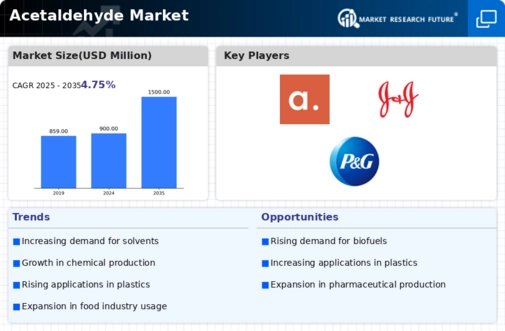Top Industry Leaders in the Acetaldehyde Market

Acetaldehyde, a key industrial chemical with diverse applications, finds itself amidst a dynamic and evolving market landscape. Understanding the competitive forces shaping this landscape is crucial for both established players and newcomers seeking to thrive in this sector. This comprehensive write-up delves into the acetaldehyde market, exploring its strategies, key influencers, recent developments, and future prospects.
Market Strategies: Key Differentiators
Companies in the acetaldehyde market employ a range of strategies to gain an edge over their competitors. These include:
-
Product Specialization: Some players focus on specific acetaldehyde grades or derivatives, catering to niche market demands with tailored solutions. For example, Showa Denko K.K. excels in high-purity acetaldehyde for pharmaceutical applications. -
Geographical Focus: Others concentrate on regional markets, building strong production and distribution networks in areas with high growth potential. Lonza's dominance in Europe exemplifies this approach. -
Vertical Integration: Integrating upstream and downstream operations secures raw material supplies and enhances cost control. Celanese Corporation's backward integration into ethylene production is a prime example. -
Technological Innovation: Continuous research and development in production processes, product enhancements, and sustainability initiatives drive market differentiation. Eastman Chemical Company's focus on green acetaldehyde technologies is a prime mover in this aspect. -
Strategic Partnerships: Collaborations with other companies in the value chain unlock new opportunities and facilitate market expansion. BASF SE's joint ventures with Chinese players like CNPC exemplify this strategy.
Factors Influencing Market Share
Beyond strategies, several key factors influence market share in the acetaldehyde market:
-
Production Capacity and Efficiency: Companies with large, efficient production facilities have a cost advantage and can cater to larger demands. Sumitomo Chemical Co., Ltd.'s global production footprint is a testament to this factor. -
Product Quality and Consistency: Consistent supply of high-quality acetaldehyde is critical for securing long-term contracts and customer loyalty. Merck KGaA's reputation for stringent quality control sets them apart. -
Regulatory Landscape: Stringent environmental regulations and safety standards can impact production costs and market access. Companies with strong compliance records, like Jubilant Life Sciences, gain an edge in such scenarios. -
Downstream Industry Trends: Growth in key downstream industries like chemicals, food & beverages, and pharmaceuticals directly drives acetaldehyde demand. Understanding and anticipating these trends is crucial for market leaders.
Key Players
Some of the prominent manufacturers in the Acetaldehyde Market are Celanese Corporation (U.S.), Eastman Chemical Company (U.S.), Merck KGaA (Germany), Sumitomo Corporation (Japan), SEKAB (Sweden), SHOWA DENKO K.K. (Japan), Jubilant Life Sciences Ltd. (India), Ashok Alco- chem Limited (India), LCY Group (Taiwan), Laxmi Organic Industries Ltd. (India), Lonza (Switzerland), Naran Lala Pvt. Ltd. (India), Eurochem Group AG (Switzerland), Wacker Chemie AG (Germany), and China National Petroleum Corporation (China).
Recent Developments:
July 2023: BASF SE and CNPC announce a joint venture to build a new acetaldehyde production facility in China, further intensifying competition in the region.
September 2023: Eastman Chemical Company successfully pilots its green acetaldehyde technology, paving the way for wider adoption and potential market disruption.
October 2023: The US Food and Drug Administration approves a new drug containing an acetaldehyde derivative, boosting demand for pharmaceutical-grade acetaldehyde.
December 2023: Jubilant Life Sciences expands its acetaldehyde production capacity in Europe, aiming to capture a larger share of the growing regional market.

